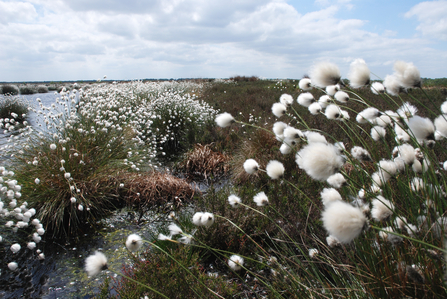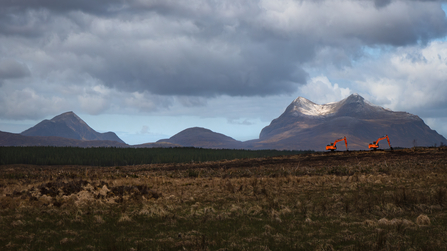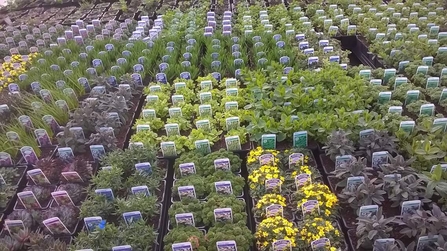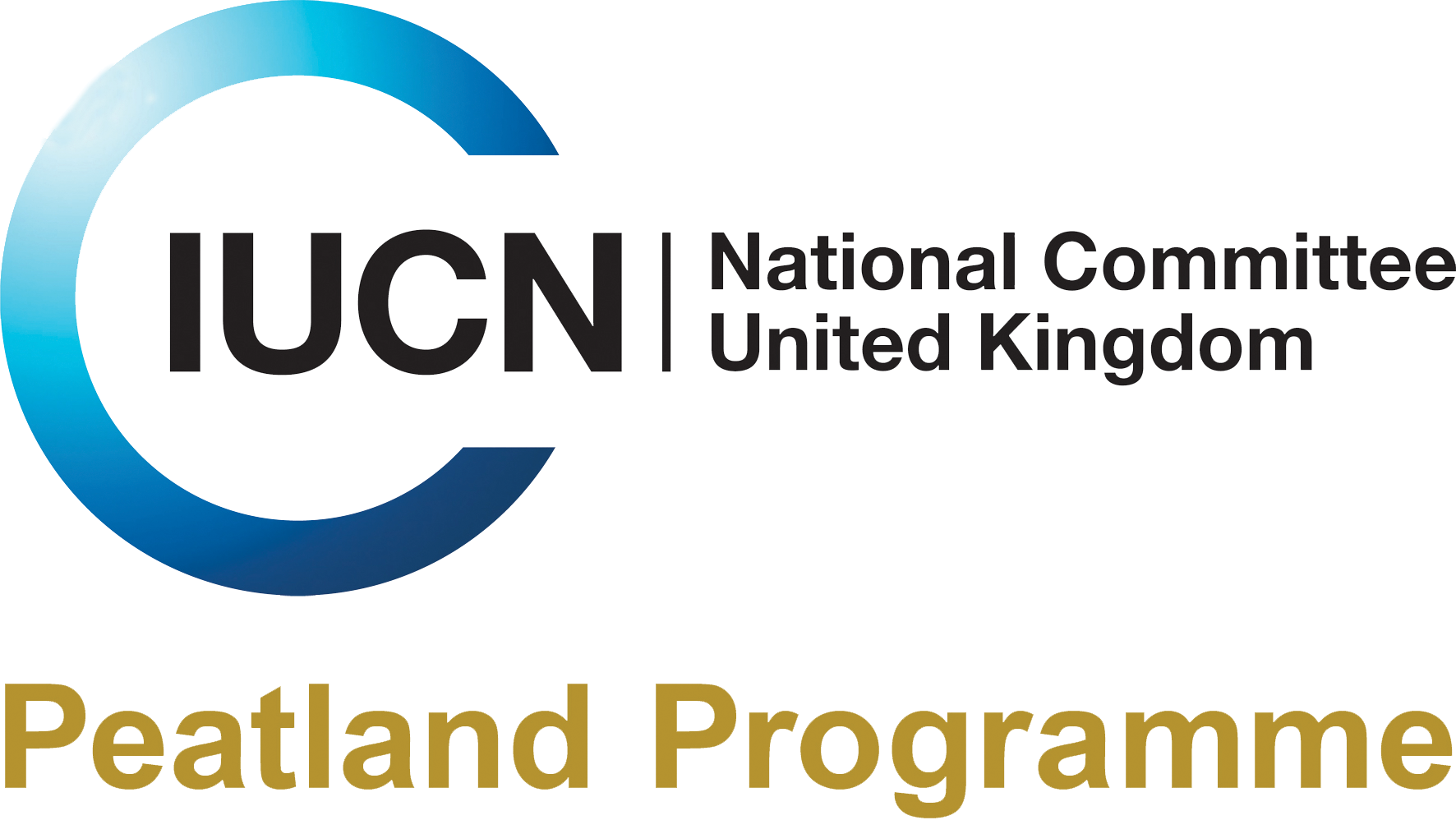We welcome this week the publication of the Committee on Climate Change (CCC) 7th Carbon Budget Report. It is now five years since the 6th report and it is useful to see the progress that has been made towards Net Zero, but also to understand the challenges that lie ahead for UK peatlands.
Committee on Climate Change (CCC) 7th Carbon Budget Report - a response from IUCN UK Peatland Programme
The IUCN UK Peatland Programme welcomes this week the publication of the Committee on Climate Change (CCC) 7th Carbon Budget Report. It is now five years since the 6th report and it is useful to see the progress that has been made towards Net Zero, but also to understand the challenges that lie ahead for UK peatlands.

Hare's-tail Cottongrass on Humberhead levels. Credit: Peter Roworth, Natural England.
Key takeaways for peatlands overall:
- Peatlands are reaffirmed in the report as a vital part of the pathway to Net Zero and the report calls for a significant ramp up in restoration from 13,000 ha per annum to 49,000 ha. As we highlight in previous direct communications with CCC and through our UK Peatland Strategy Report, we understand that there is not comprehensive UK restoration delivery data available. Work to co-ordinate this data is underway through, for example, the Peat Restoration Register in England. Our own calculations suggest that the 2023 figures cited in the report represent an underestimate of true restoration delivery through partners. But we also acknowledge and support the CCCs messaging that we are off track to deliver against government targets and that action needs to scale with urgency.
- The proportion of peatlands in natural or rewetted conditions is forecast in the report to rise from 26% in 2023 to 55% by 2040. This scale up is forecast to deliver over half of land use emission reductions to 2040. However, as a proportion of the ~3 million ha UK peatland area, this remains a significantly lower percentage than the 2 million ha under “conservation, restoration or sustainable management by 2040” that the 2018 UK Peatland Strategy calls for.
- Targets for future upland peat restoration totals have however been reduced from previous targets of 100% to 79% by 2050. The report further states that:
“In the Balanced Pathway, the total restored or near natural area rises from the current 30% to 60% by 2040, with annual rewetting rates reaching 45,000 hectares between 2030 and 2050.” The emissions reductions projected from this lower target remain similar in the report, however any alterations in the assumptions around climate change scenarios may impact this [Royal Society of Wildlife Trusts blog]. - The ambition for lowland peatland restoration is percentage wise lower than for the upland (from 9% to 56% by 2050) however, relatively the ambition is around the same percentage uplift for both.
- Lowland peat ‘under raised water-table management’ is separated from the restoration ambition and targeted to increased from 0% at present to 10% by 2050. It is not entirely clear in the report but we have taken this to be peatlands which will remain under production (potentially some under paludiculture systems) and thus separated from lowland peat restoration. It is helpful to have ambition in these lowland agricultural landscapes separated out.
- While peatlands have the potential to be a significant sink for carbon, they are currently the most significant emitter (15 MtCO2e in 2022) in land use terms. Forestry and peatland figures are disaggregated in the report. However, this is not always the case and, in some reports, data is combined which obscures that peatlands are a major source of emissions. All sources must be addressed to ensure that our peatland delivery remains balanced across delivering climate benefits in tandem with nature, water and societal benefits.

Forest to bog restoration on Cul Mor. Credit: David Brown.
Key takeaways for peatlands in farming and horticulture:
- Croplands are the major source of emissions (13.6 MtCO2e) driven by the degradation of largely fen peatlands in lowland settings.
- There is considerable emphasis throughout placed on the importance of diversification, particularly around reductions in livestock production and a requirement to undertake habitat creation, restoration and management activities in return for subsidy.
- There will need to be a focus on releasing some agricultural land with urgency in order to grow the natural carbon sink, particularly as there will be a lag time between creation and restoration activities taking place and the sites becoming a significant sink.
- The report discusses the need for horticultural production to shift towards greater indoor production to free up land in fen regions. However, it does not specifically discuss the need for horticultural production to also reduce reliance on peat growing mediums more generally and ensure any transition from peat in situ does not rely on the use of extracted peat.
- It is noted that increases in peatland jobs could support rural economies where there may be reductions in livestock employment opportunities.
We discuss a number of these issues in our Agricultural issues brief and the associated recommended actions for policy makers, in regards to ensuring a just transition for farmers and beneficial outcomes for peatlands.

Quinky plants grown in peat-free nursery, Wales. Credit: Charles Warner.
Omissions:
- There is discussion of water-table management in lowland contexts, but no mention of internal drainage boards (IDBs) in relation to this. The greater regulation of the activities of IDBs will be vital in delivering some of the report targets in lowland peatland settings, this lack of regulation at both government and local levels was highlighted in this 2017 Defra report.
- It is also noted that peatlands “can help regulate water availability and quality across catchments”, this somewhat downplays that 43% of the UK population are reliant on peatland sources for their water provisioning.
- Capacity issues are highlighted in relation to tree planting, however we have identified similar issues in peatland restoration across the UK nations, in addition to the need for a secure funding pipeline to build contractor and employer confidence to upskill employees and purchase equipment [UK peatland strategy progress report 2024]. The report also highlights that peatland restoration costs remain uncertain, one way to combat this would be to index link funding so that it does remain a static amount over potentially long timeframes.
- We would also emphasise that although the cost of fully restoring the UK’s peatlands may seem high, restoring just 55% would lead to an estimated saving to the economy of £41-55 billion in GHG emissions reductions over a 100 year period according to the Office for National Statistics.
